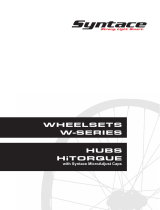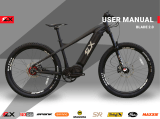Page is loading ...

© Copyright Trek Bicycle Corporation 2004
All rights reserved
Part Number 253510
Table of contents
Read this manual before you ride
...............................................................
..
2
Properly install your tires
...............................................................
..............
2
Use only carbon-specific brake pads
.............................................................
2
With carbon rims, avoid certain chemicals, abrasives, or extreme heat
......
3
Bontrager limited warranty
...............................................................
...........
4
Figure 1- Bontrager Race XXX Lite Carbon wheelset
CARBON FIBER WHEELSET OWNER'S MANUAL
This supplement is in addition to the Bontrager Wheelset Owner's Manual.
Please read all of the supplied instruction manuals thoroughly before using
your new carbon clincher wheelset; the manuals contain important safety and
maintenance information.
If you do not understand the information in this manual, or you have a
question about your wheelset that this manual does not cover, consult your
Bontrager dealer. If you have a question or problem that your Bontrager dealer
can’t handle, contact us at:
Bontrager Components
920.478.4678
Attn: Customer Service
http://www.bontrager.com
801 W. Madison Street
Waterloo, Wisconsin 53594
Waterloo, Wisconsin 53594
READ THIS MANUAL BEFORE YOU RIDE

2
Introduction
This manual covers the Bontrager Race XXX Lite Carbon tubular and clincher
wheelsets and the Bontrager Race X Lite Aero Carbon tubular wheelset.These
wheels are constructed with carbon composite rims. The carbon composite
material is very light weight and strong, but requires some special care and
maintenance. Before riding your new Bontrager carbon wheelset, read and
follow your Bontrager Wheelset Owner’s Manual, and also the following special
Bontrager carbon wheelset instructions.
Properly install your tires
The
Bontrager carbon clincher
wheelset uses clincher, or wired-on tires
(only). When installing or removing your clincher tires, do not use metal tire
levers. The maximum inflation on this wheelset is 120psi (8.3atm). Overinflation
may damage the rim.
The
Bontrager carbon tubular
wheelsets use tubular type tires (only).
Do not ride these wheels without properly attaching the tubular tires. Tubular
tires require regular maintenance and inspection for attachment to the rim.
Failure to properly fasten, inspect and maintain the tires may cause the tire to
separate from the rim causing a loss of control resulting in injury. For instruc-
tions on fastening tubular tires to these rims, or maintaining tubular tires,
consult the tire manufacturer, or your dealer.
Prior to the first application of rim cement on a new carbon fiber rim the
tire well or bed, where the tire contacts the rim, should be roughened. It is
recommended that this procedure be done by your dealer. To roughen the tire
well of the rim, lightly sand with a 400 grit sandpaper.
Use only carbon-specific brake pads
Carbon rims require special brake pads to prevent heat fade and to work
properly in wet conditions. Heat fade is a loss of braking performance after
long, hard brake application. Carbon fiber rims also can be extremely abrasive
in wet conditions, causing standard brake pads to wear prematurely. Only use
Bontrager Carbon Brake Pads or a similar product with carbon fiber rims.
If your bicycle has carbon fiber rims, also follow the carbon fiber composite
inspection procedures.
With carbon rims, avoid certain chemicals, abrasives, or
extreme heat
When cleaning composite parts, do not use solvents, abrasives, or harsh
chemicals. Remove road film with a soft rag and a mild detergent and water
solution. Use of industrial solvents for cleaning or glue removal may damage
not only the rim finish but also the adhesive which joins the rim parts. To clean
rims, wipe them with acetone and a clean soft cloth.
Excessive heat, such as that used in powder coating, or any open flame, may
damage the adhesive which joins the rim parts. Do not exceed 180º F. (82º C.)
exposure to your composite rims.
Removing paint from an OCLV rim requires special techniques and so should
WARNING
A tubular tire that is not properly attached (glued) to the
A tubular tire that is not properly attached (glued) to the
rim may allow the tire to be loose or come off unexpectedly,
rim may allow the tire to be loose or come off unexpectedly,
causing you to lose control and fall. Follow the tire manufac-
causing you to lose control and fall. Follow the tire manufac-
turer's instructions for proper installation.
turer's instructions for proper installation.

3
only be done at the factory. See your dealer for more information.
Modifying the wheelset (including hubs, spokes, nipples or rims) in any way
will void the manufacturers warranty and may be unsafe.
Inspect carbon fiber parts frequently
Unlike metal parts, carbon composite parts that have been damaged may not
bend, bulge or deform; a damaged part may appear to be normal to a cursory
glance. After any high force load, like a crash, or other impact to your bicycle,
thoroughly inspect all the parts of your bike, and use the following procedures
to inspect carbon composite parts.
To check a part for surface problems (visual test)
1. Clean the part thoroughly with a damp cloth.
2. Look closely for problems: scratches, gouges, cracks, loose fibers (which will
appear like thin hairs), or other surface flaws
3. If the part has any problems, do not ride the bike. Take the bike to your
dealer for replacement or further inspection.
To check a part for loss of rigidity (flex test)
1. Use the part in a normal manner (without actually riding) while someone
watches carefully for unexpected movement. As an example, if you suspect
a composite seatpost has been damaged, sit gently on the saddle while
someone watches to see if the seatpost flexes.
2. If the helper sees the part flex unexpectedly, or if the part feels less rigid than
it should be, do not ride the bike. Take the bike to your dealer for replace-
ment or further inspection.
To check a part for delamination (tap test)
1. Clean the part thoroughly with a damp cloth.
2. With a nickel or other coin, tap the part near any possible damage, and places
where the part is known to be in good condition (or use a similar part).
3. Listen carefully for variations in sound, especially a hollow sound, “dead”
tone, or any sound indicating that the part is not solid.
4. If the part makes any noise other than a hard, solid tap sound, do not ride
the bike. Take the bike to your dealer for replacement or further inspection.
WARNING
A damaged carbon fiber part can fail suddenly, causing
serious injury or death. Inspect for damage frequently. If
serious injury or death. Inspect for damage frequently. If
you suspect a carbon fiber part is damaged, replace the part
you suspect a carbon fiber part is damaged, replace the part
before riding, or take the bike to your dealer for service.
before riding, or take the bike to your dealer for service.

4
Bontrager Limited Warranty
Trek Bicycle Corporation warrants each new Bontrager wheelset against defects
in workmanship and materials.
This warranty covers-
The wheelset for the a period of one year from the date of sale.
This warranty does not cover-
• Normal wear and tear
• Improper assembly
• Improper follow-up maintenance
• Installation of parts or accessories not originally intended for, or compatible
with, the wheels as sold
• Damage or failure due to accident, misuse, abuse, or neglect
• Labor charges for part replacement or changeover
This warranty is void in its entirety by any modification of the wheelset or its
components.
This warranty is expressly limited to the repair or replacement of a defective
item and is the sole remedy of the warranty. This warranty extends from the
date of purchase, applies only to the original owner, and is not transferable.
Trek is not responsible for incidental or consequential damages. Some states
do not allow the exclusion of incidental or consequential damages, so the above
exclusion may not apply to you.
Claims under this warranty must be made through an authorized dealer. Proof
of purchase is required.
This warranty gives the consumer specific legal rights, and those rights may
vary from place to place. This warranty does not affect the statutory rights of
the consumer.
/



